University of East London: Automation in Construction Dissertation
VerifiedAdded on 2022/12/20
|74
|17896
|1
Thesis and Dissertation
AI Summary
This dissertation, submitted to the University of East London, explores the effects of automation within the UK construction industry. The research investigates the current state of automation, including the use of robots, BIM, pre-engineered buildings, and automation at both site and industry levels. It assesses the advantages and disadvantages of automation, along with a feasibility study to determine its impact. The study utilizes quantitative analysis, including a Likert scale, to evaluate the perceptions and experiences of industry professionals. The dissertation also addresses health and safety implications, offering strategies for successful implementation. The research covers a wide array of automation technologies, including 3D printing, prefabricated structures, and various construction techniques. The findings are presented using graphs and tables to provide a comprehensive overview of the automation landscape in the UK construction sector, aiming to inform and improve industry practices.
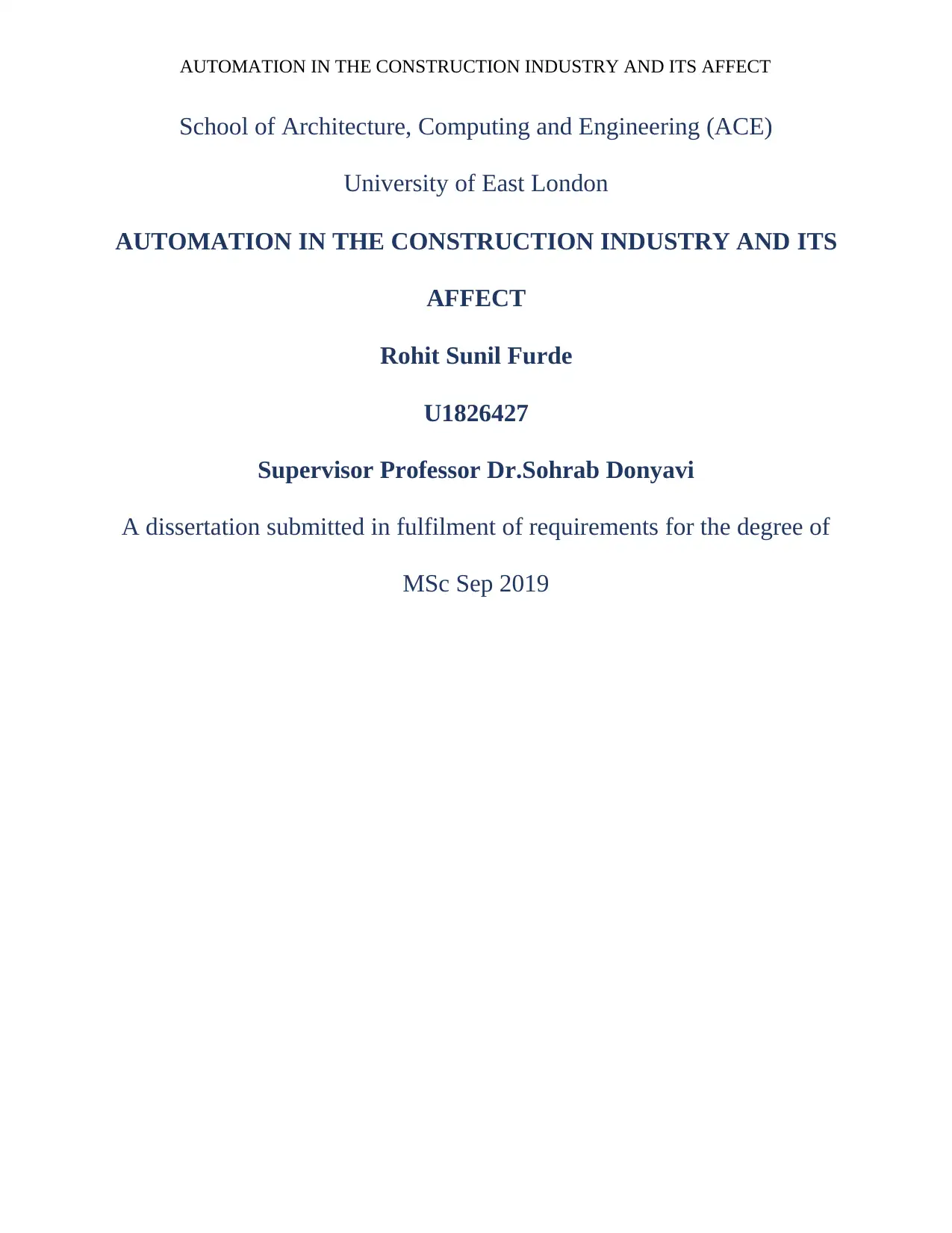
AUTOMATION IN THE CONSTRUCTION INDUSTRY AND ITS AFFECT
School of Architecture, Computing and Engineering (ACE)
University of East London
AUTOMATION IN THE CONSTRUCTION INDUSTRY AND ITS
AFFECT
Rohit Sunil Furde
U1826427
Supervisor Professor Dr.Sohrab Donyavi
A dissertation submitted in fulfilment of requirements for the degree of
MSc Sep 2019
School of Architecture, Computing and Engineering (ACE)
University of East London
AUTOMATION IN THE CONSTRUCTION INDUSTRY AND ITS
AFFECT
Rohit Sunil Furde
U1826427
Supervisor Professor Dr.Sohrab Donyavi
A dissertation submitted in fulfilment of requirements for the degree of
MSc Sep 2019
Paraphrase This Document
Need a fresh take? Get an instant paraphrase of this document with our AI Paraphraser
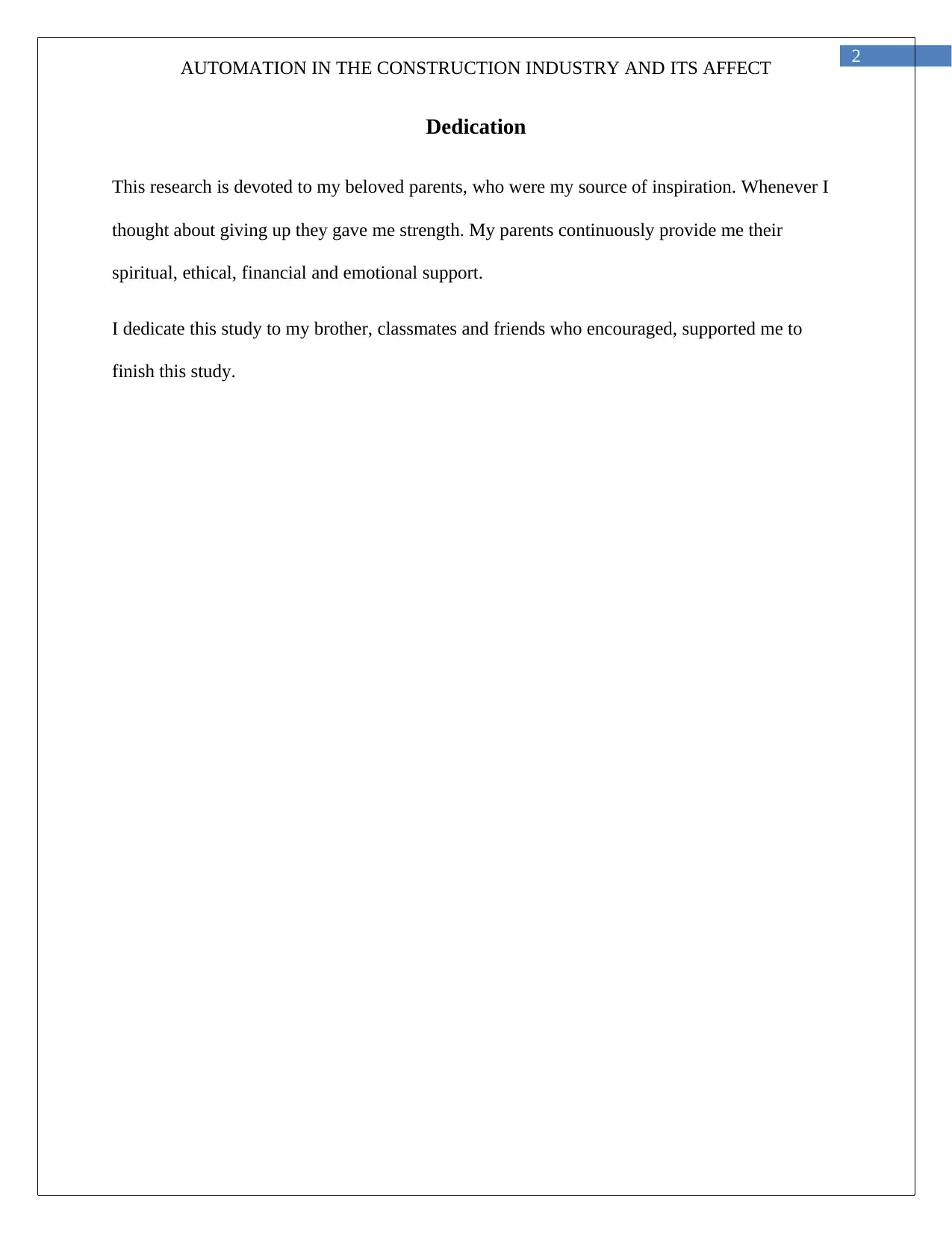
AUTOMATION IN THE CONSTRUCTION INDUSTRY AND ITS AFFECT 2
Dedication
This research is devoted to my beloved parents, who were my source of inspiration. Whenever I
thought about giving up they gave me strength. My parents continuously provide me their
spiritual, ethical, financial and emotional support.
I dedicate this study to my brother, classmates and friends who encouraged, supported me to
finish this study.
Dedication
This research is devoted to my beloved parents, who were my source of inspiration. Whenever I
thought about giving up they gave me strength. My parents continuously provide me their
spiritual, ethical, financial and emotional support.
I dedicate this study to my brother, classmates and friends who encouraged, supported me to
finish this study.
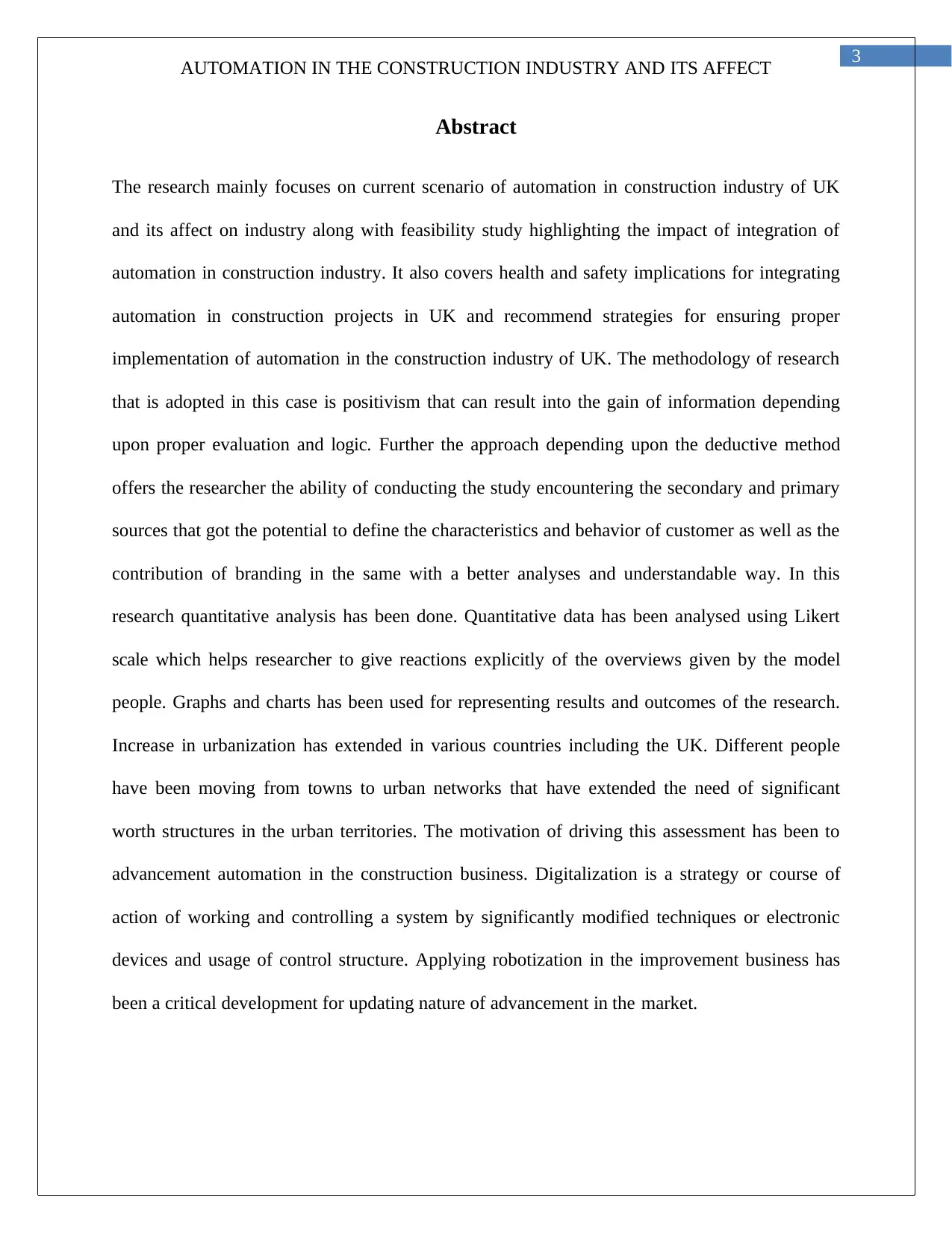
AUTOMATION IN THE CONSTRUCTION INDUSTRY AND ITS AFFECT 3
Abstract
The research mainly focuses on current scenario of automation in construction industry of UK
and its affect on industry along with feasibility study highlighting the impact of integration of
automation in construction industry. It also covers health and safety implications for integrating
automation in construction projects in UK and recommend strategies for ensuring proper
implementation of automation in the construction industry of UK. The methodology of research
that is adopted in this case is positivism that can result into the gain of information depending
upon proper evaluation and logic. Further the approach depending upon the deductive method
offers the researcher the ability of conducting the study encountering the secondary and primary
sources that got the potential to define the characteristics and behavior of customer as well as the
contribution of branding in the same with a better analyses and understandable way. In this
research quantitative analysis has been done. Quantitative data has been analysed using Likert
scale which helps researcher to give reactions explicitly of the overviews given by the model
people. Graphs and charts has been used for representing results and outcomes of the research.
Increase in urbanization has extended in various countries including the UK. Different people
have been moving from towns to urban networks that have extended the need of significant
worth structures in the urban territories. The motivation of driving this assessment has been to
advancement automation in the construction business. Digitalization is a strategy or course of
action of working and controlling a system by significantly modified techniques or electronic
devices and usage of control structure. Applying robotization in the improvement business has
been a critical development for updating nature of advancement in the market.
Abstract
The research mainly focuses on current scenario of automation in construction industry of UK
and its affect on industry along with feasibility study highlighting the impact of integration of
automation in construction industry. It also covers health and safety implications for integrating
automation in construction projects in UK and recommend strategies for ensuring proper
implementation of automation in the construction industry of UK. The methodology of research
that is adopted in this case is positivism that can result into the gain of information depending
upon proper evaluation and logic. Further the approach depending upon the deductive method
offers the researcher the ability of conducting the study encountering the secondary and primary
sources that got the potential to define the characteristics and behavior of customer as well as the
contribution of branding in the same with a better analyses and understandable way. In this
research quantitative analysis has been done. Quantitative data has been analysed using Likert
scale which helps researcher to give reactions explicitly of the overviews given by the model
people. Graphs and charts has been used for representing results and outcomes of the research.
Increase in urbanization has extended in various countries including the UK. Different people
have been moving from towns to urban networks that have extended the need of significant
worth structures in the urban territories. The motivation of driving this assessment has been to
advancement automation in the construction business. Digitalization is a strategy or course of
action of working and controlling a system by significantly modified techniques or electronic
devices and usage of control structure. Applying robotization in the improvement business has
been a critical development for updating nature of advancement in the market.
⊘ This is a preview!⊘
Do you want full access?
Subscribe today to unlock all pages.

Trusted by 1+ million students worldwide
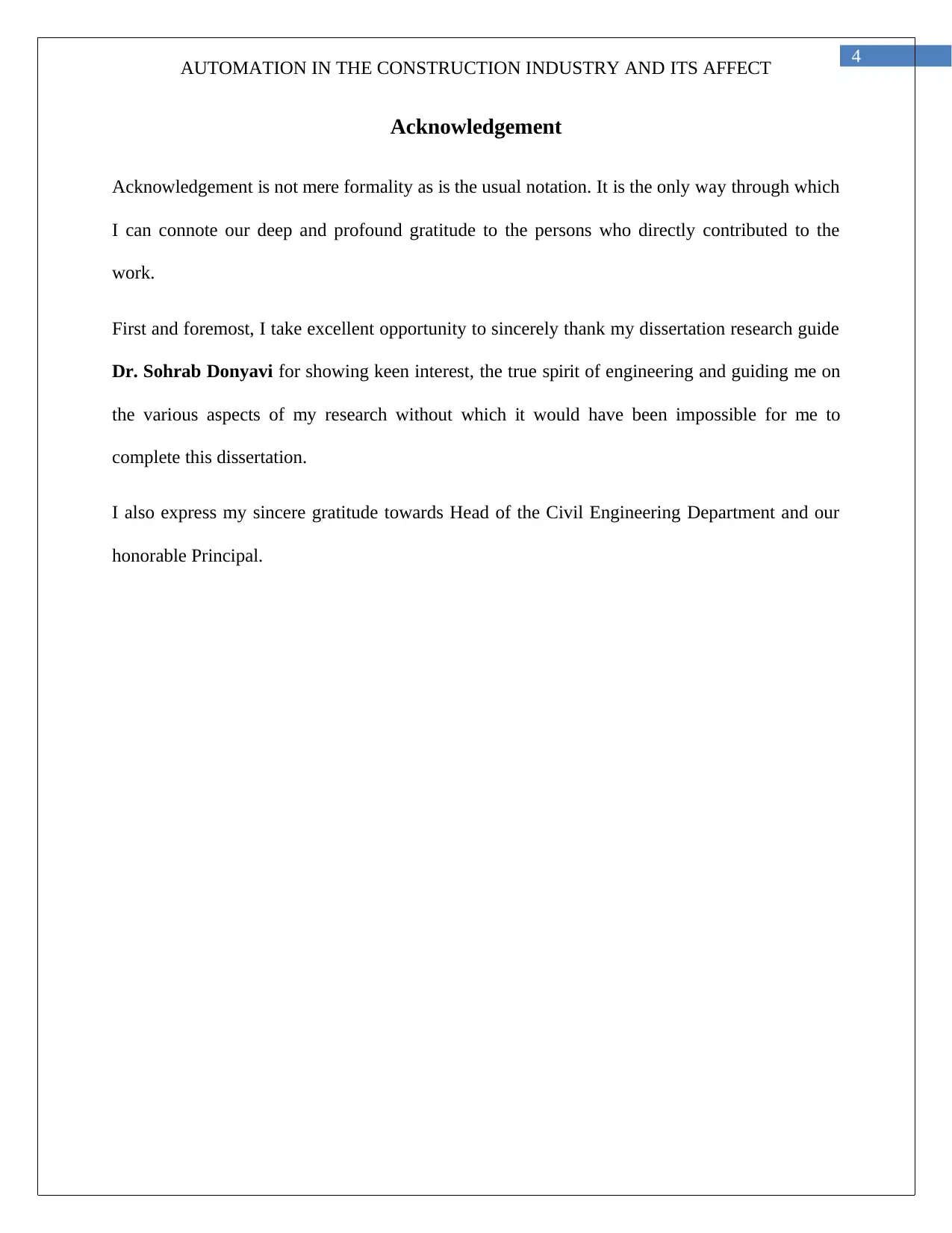
AUTOMATION IN THE CONSTRUCTION INDUSTRY AND ITS AFFECT 4
Acknowledgement
Acknowledgement is not mere formality as is the usual notation. It is the only way through which
I can connote our deep and profound gratitude to the persons who directly contributed to the
work.
First and foremost, I take excellent opportunity to sincerely thank my dissertation research guide
Dr. Sohrab Donyavi for showing keen interest, the true spirit of engineering and guiding me on
the various aspects of my research without which it would have been impossible for me to
complete this dissertation.
I also express my sincere gratitude towards Head of the Civil Engineering Department and our
honorable Principal.
Acknowledgement
Acknowledgement is not mere formality as is the usual notation. It is the only way through which
I can connote our deep and profound gratitude to the persons who directly contributed to the
work.
First and foremost, I take excellent opportunity to sincerely thank my dissertation research guide
Dr. Sohrab Donyavi for showing keen interest, the true spirit of engineering and guiding me on
the various aspects of my research without which it would have been impossible for me to
complete this dissertation.
I also express my sincere gratitude towards Head of the Civil Engineering Department and our
honorable Principal.
Paraphrase This Document
Need a fresh take? Get an instant paraphrase of this document with our AI Paraphraser
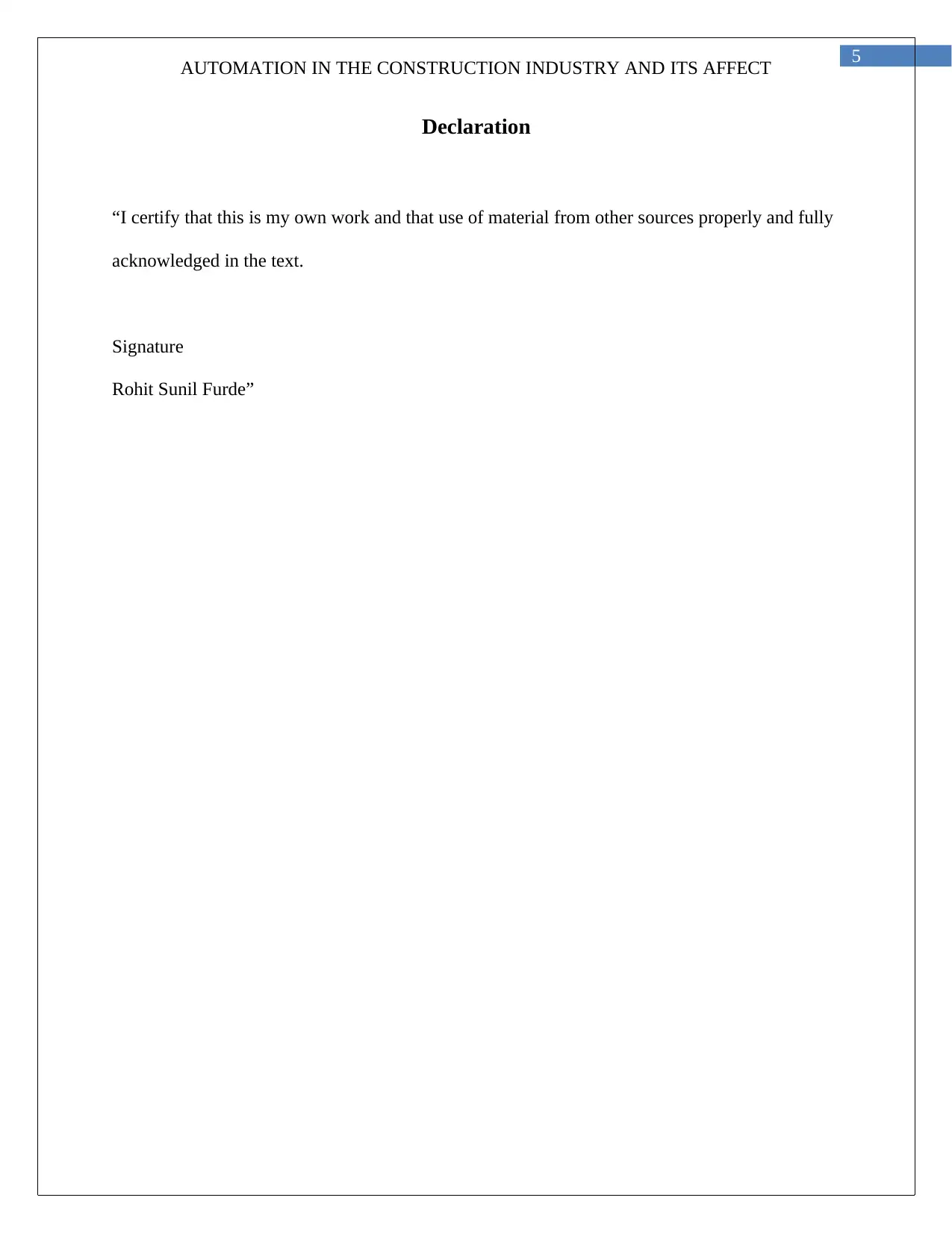
AUTOMATION IN THE CONSTRUCTION INDUSTRY AND ITS AFFECT 5
Declaration
“I certify that this is my own work and that use of material from other sources properly and fully
acknowledged in the text.
Signature
Rohit Sunil Furde”
Declaration
“I certify that this is my own work and that use of material from other sources properly and fully
acknowledged in the text.
Signature
Rohit Sunil Furde”
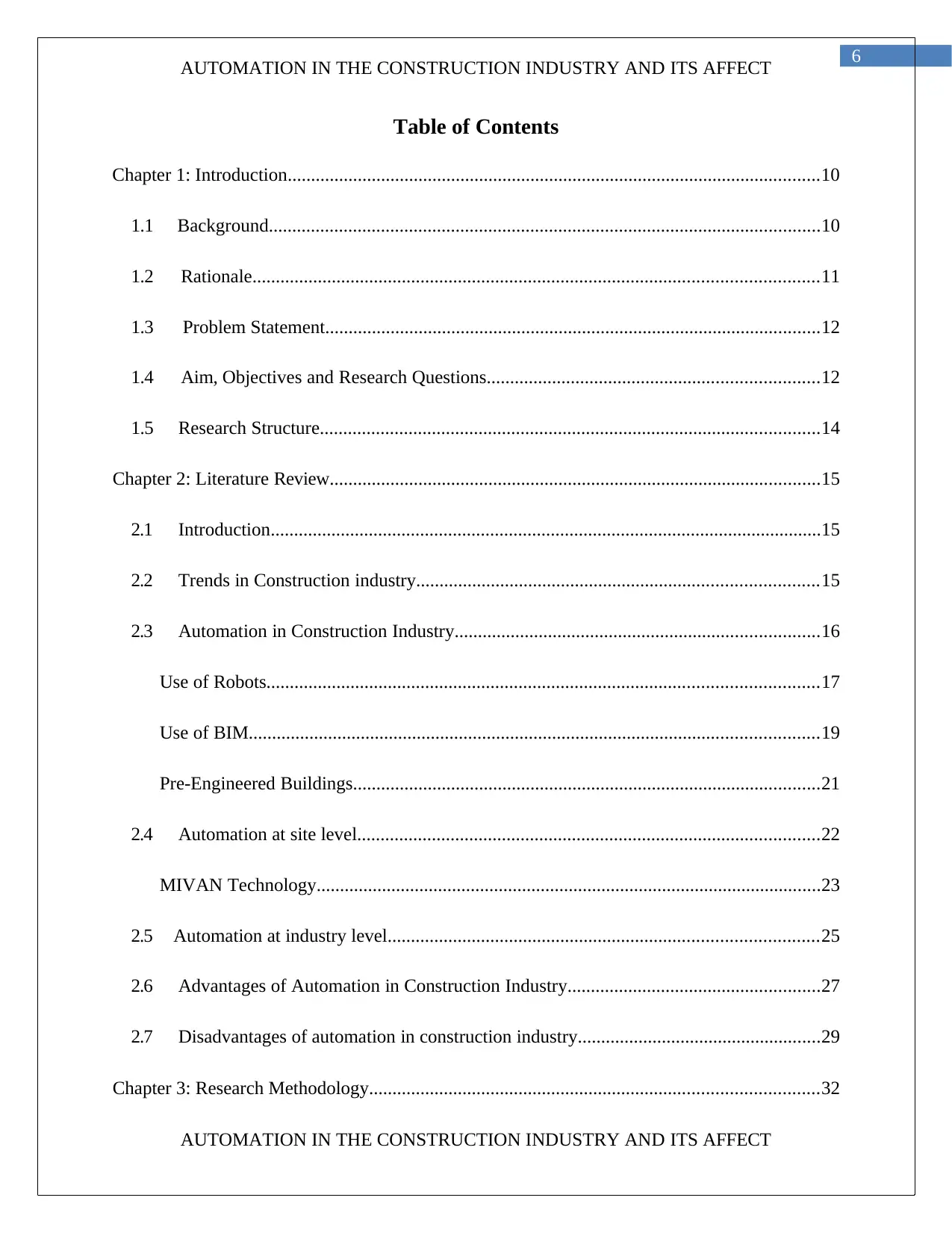
AUTOMATION IN THE CONSTRUCTION INDUSTRY AND ITS AFFECT 6
Table of Contents
Chapter 1: Introduction..................................................................................................................10
1.1 Background......................................................................................................................10
1.2 Rationale.........................................................................................................................11
1.3 Problem Statement..........................................................................................................12
1.4 Aim, Objectives and Research Questions.......................................................................12
1.5 Research Structure...........................................................................................................14
Chapter 2: Literature Review.........................................................................................................15
2.1 Introduction......................................................................................................................15
2.2 Trends in Construction industry......................................................................................15
2.3 Automation in Construction Industry..............................................................................16
Use of Robots......................................................................................................................17
Use of BIM..........................................................................................................................19
Pre-Engineered Buildings....................................................................................................21
2.4 Automation at site level...................................................................................................22
MIVAN Technology............................................................................................................23
2.5 Automation at industry level............................................................................................25
2.6 Advantages of Automation in Construction Industry......................................................27
2.7 Disadvantages of automation in construction industry....................................................29
Chapter 3: Research Methodology................................................................................................32
AUTOMATION IN THE CONSTRUCTION INDUSTRY AND ITS AFFECT 7
Table of Contents
Chapter 1: Introduction..................................................................................................................10
1.1 Background......................................................................................................................10
1.2 Rationale.........................................................................................................................11
1.3 Problem Statement..........................................................................................................12
1.4 Aim, Objectives and Research Questions.......................................................................12
1.5 Research Structure...........................................................................................................14
Chapter 2: Literature Review.........................................................................................................15
2.1 Introduction......................................................................................................................15
2.2 Trends in Construction industry......................................................................................15
2.3 Automation in Construction Industry..............................................................................16
Use of Robots......................................................................................................................17
Use of BIM..........................................................................................................................19
Pre-Engineered Buildings....................................................................................................21
2.4 Automation at site level...................................................................................................22
MIVAN Technology............................................................................................................23
2.5 Automation at industry level............................................................................................25
2.6 Advantages of Automation in Construction Industry......................................................27
2.7 Disadvantages of automation in construction industry....................................................29
Chapter 3: Research Methodology................................................................................................32
AUTOMATION IN THE CONSTRUCTION INDUSTRY AND ITS AFFECT 7
⊘ This is a preview!⊘
Do you want full access?
Subscribe today to unlock all pages.

Trusted by 1+ million students worldwide
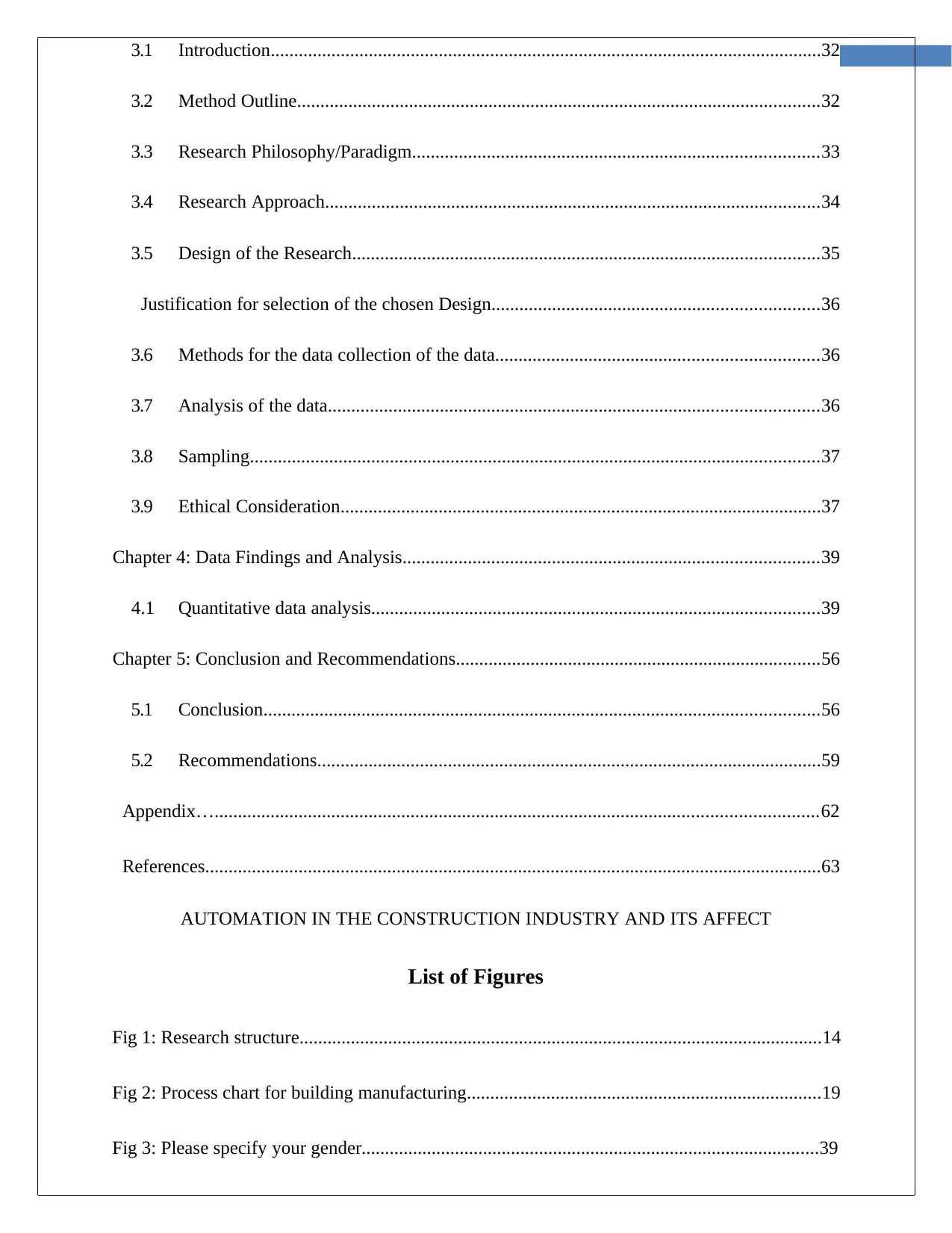
3.1 Introduction......................................................................................................................32
3.2 Method Outline................................................................................................................32
3.3 Research Philosophy/Paradigm.......................................................................................33
3.4 Research Approach..........................................................................................................34
3.5 Design of the Research....................................................................................................35
Justification for selection of the chosen Design......................................................................36
3.6 Methods for the data collection of the data.....................................................................36
3.7 Analysis of the data.........................................................................................................36
3.8 Sampling..........................................................................................................................37
3.9 Ethical Consideration.......................................................................................................37
Chapter 4: Data Findings and Analysis.........................................................................................39
4.1 Quantitative data analysis................................................................................................39
Chapter 5: Conclusion and Recommendations..............................................................................56
5.1 Conclusion.......................................................................................................................56
5.2 Recommendations............................................................................................................59
Appendix….................................................................................................................................62
References....................................................................................................................................63
AUTOMATION IN THE CONSTRUCTION INDUSTRY AND ITS AFFECT 8
List of Figures
Fig 1: Research structure................................................................................................................14
Fig 2: Process chart for building manufacturing............................................................................19
Fig 3: Please specify your gender..................................................................................................39
3.2 Method Outline................................................................................................................32
3.3 Research Philosophy/Paradigm.......................................................................................33
3.4 Research Approach..........................................................................................................34
3.5 Design of the Research....................................................................................................35
Justification for selection of the chosen Design......................................................................36
3.6 Methods for the data collection of the data.....................................................................36
3.7 Analysis of the data.........................................................................................................36
3.8 Sampling..........................................................................................................................37
3.9 Ethical Consideration.......................................................................................................37
Chapter 4: Data Findings and Analysis.........................................................................................39
4.1 Quantitative data analysis................................................................................................39
Chapter 5: Conclusion and Recommendations..............................................................................56
5.1 Conclusion.......................................................................................................................56
5.2 Recommendations............................................................................................................59
Appendix….................................................................................................................................62
References....................................................................................................................................63
AUTOMATION IN THE CONSTRUCTION INDUSTRY AND ITS AFFECT 8
List of Figures
Fig 1: Research structure................................................................................................................14
Fig 2: Process chart for building manufacturing............................................................................19
Fig 3: Please specify your gender..................................................................................................39
Paraphrase This Document
Need a fresh take? Get an instant paraphrase of this document with our AI Paraphraser
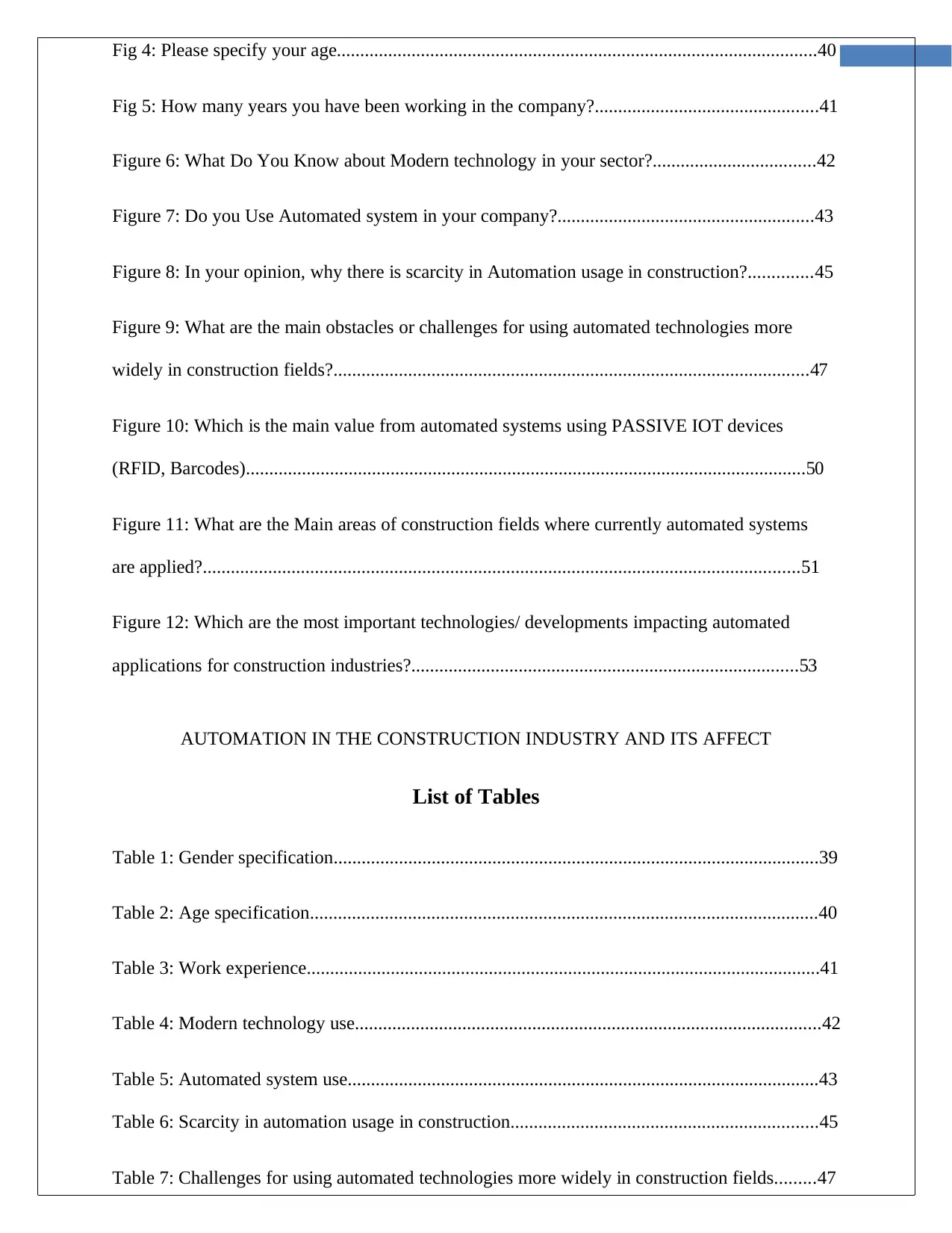
Fig 4: Please specify your age.......................................................................................................40
Fig 5: How many years you have been working in the company?................................................41
Figure 6: What Do You Know about Modern technology in your sector?...................................42
Figure 7: Do you Use Automated system in your company?.......................................................43
Figure 8: In your opinion, why there is scarcity in Automation usage in construction?..............45
Figure 9: What are the main obstacles or challenges for using automated technologies more
widely in construction fields?......................................................................................................47
Figure 10: Which is the main value from automated systems using PASSIVE IOT devices
(RFID, Barcodes)........................................................................................................................50
Figure 11: What are the Main areas of construction fields where currently automated systems
are applied?................................................................................................................................51
Figure 12: Which are the most important technologies/ developments impacting automated
applications for construction industries?...................................................................................53
AUTOMATION IN THE CONSTRUCTION INDUSTRY AND ITS AFFECT 9
List of Tables
Table 1: Gender specification........................................................................................................39
Table 2: Age specification.............................................................................................................40
Table 3: Work experience..............................................................................................................41
Table 4: Modern technology use....................................................................................................42
Table 5: Automated system use.....................................................................................................43
Table 6: Scarcity in automation usage in construction..................................................................45
Table 7: Challenges for using automated technologies more widely in construction fields.........47
Fig 5: How many years you have been working in the company?................................................41
Figure 6: What Do You Know about Modern technology in your sector?...................................42
Figure 7: Do you Use Automated system in your company?.......................................................43
Figure 8: In your opinion, why there is scarcity in Automation usage in construction?..............45
Figure 9: What are the main obstacles or challenges for using automated technologies more
widely in construction fields?......................................................................................................47
Figure 10: Which is the main value from automated systems using PASSIVE IOT devices
(RFID, Barcodes)........................................................................................................................50
Figure 11: What are the Main areas of construction fields where currently automated systems
are applied?................................................................................................................................51
Figure 12: Which are the most important technologies/ developments impacting automated
applications for construction industries?...................................................................................53
AUTOMATION IN THE CONSTRUCTION INDUSTRY AND ITS AFFECT 9
List of Tables
Table 1: Gender specification........................................................................................................39
Table 2: Age specification.............................................................................................................40
Table 3: Work experience..............................................................................................................41
Table 4: Modern technology use....................................................................................................42
Table 5: Automated system use.....................................................................................................43
Table 6: Scarcity in automation usage in construction..................................................................45
Table 7: Challenges for using automated technologies more widely in construction fields.........47
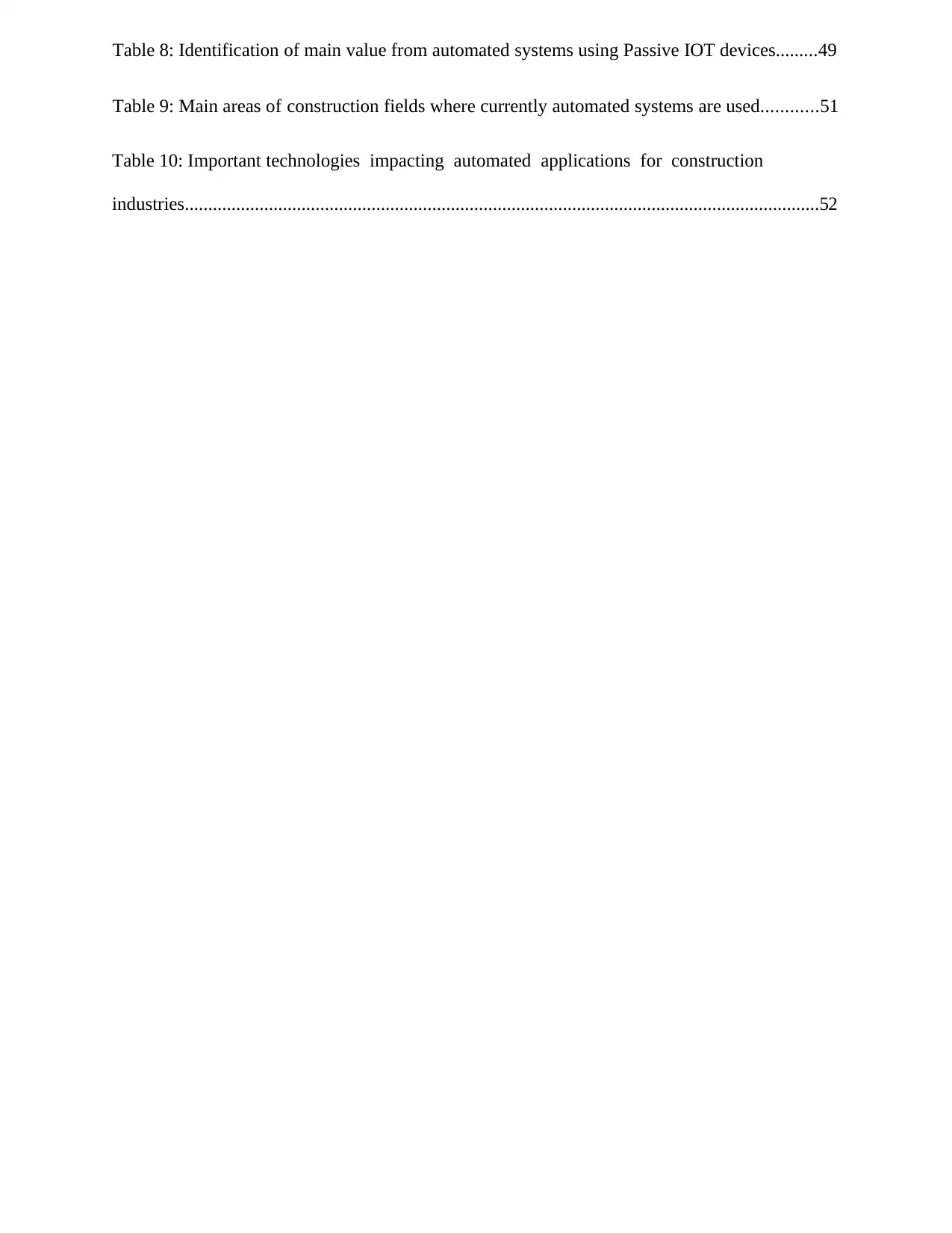
Table 8: Identification of main value from automated systems using Passive IOT devices.........49
Table 9: Main areas of construction fields where currently automated systems are used............51
Table 10: Important technologies impacting automated applications for construction
industries........................................................................................................................................52
Table 9: Main areas of construction fields where currently automated systems are used............51
Table 10: Important technologies impacting automated applications for construction
industries........................................................................................................................................52
⊘ This is a preview!⊘
Do you want full access?
Subscribe today to unlock all pages.

Trusted by 1+ million students worldwide
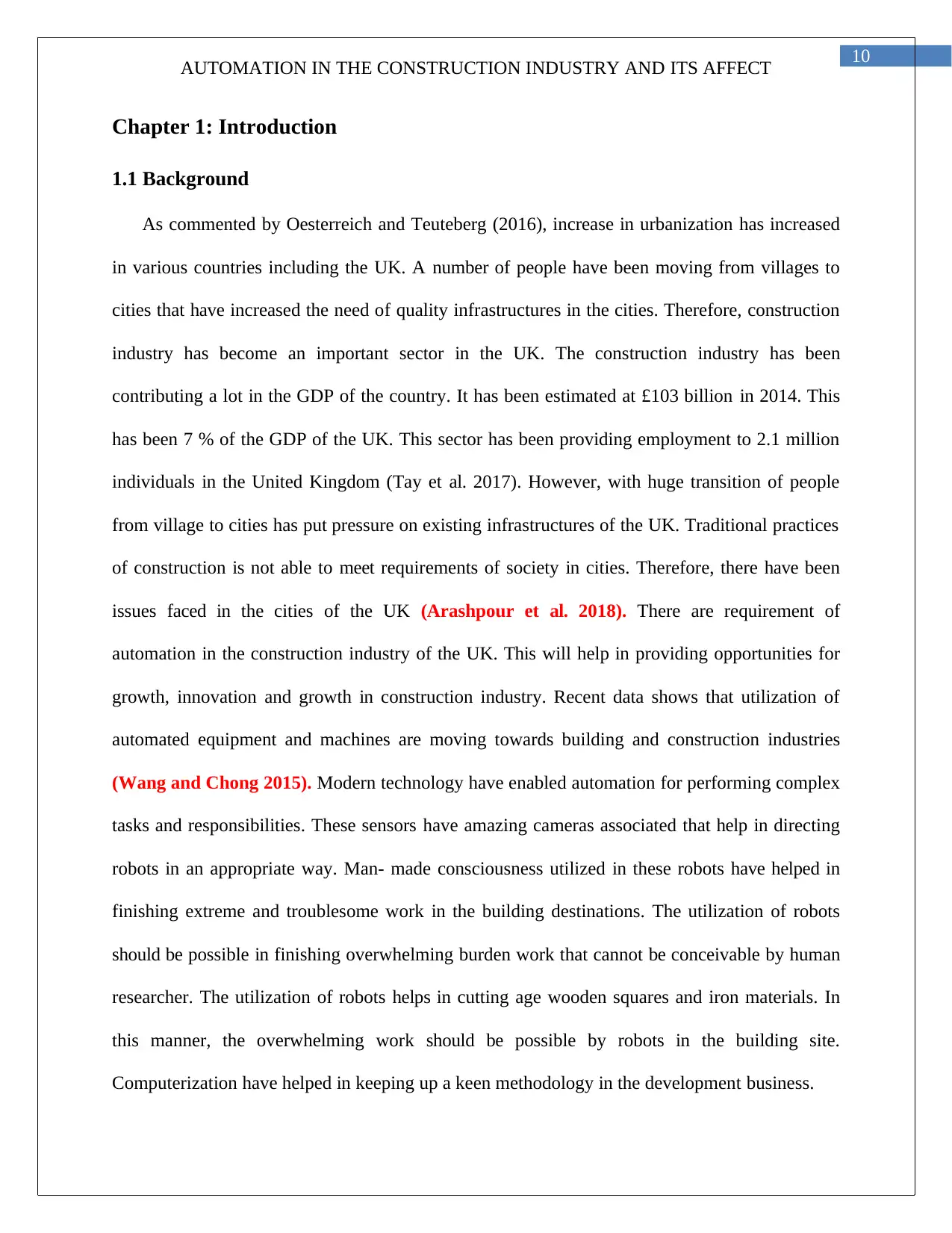
AUTOMATION IN THE CONSTRUCTION INDUSTRY AND ITS AFFECT 10
Chapter 1: Introduction
1.1 Background
As commented by Oesterreich and Teuteberg (2016), increase in urbanization has increased
in various countries including the UK. A number of people have been moving from villages to
cities that have increased the need of quality infrastructures in the cities. Therefore, construction
industry has become an important sector in the UK. The construction industry has been
contributing a lot in the GDP of the country. It has been estimated at £103 billion in 2014. This
has been 7 % of the GDP of the UK. This sector has been providing employment to 2.1 million
individuals in the United Kingdom (Tay et al. 2017). However, with huge transition of people
from village to cities has put pressure on existing infrastructures of the UK. Traditional practices
of construction is not able to meet requirements of society in cities. Therefore, there have been
issues faced in the cities of the UK (Arashpour et al. 2018). There are requirement of
automation in the construction industry of the UK. This will help in providing opportunities for
growth, innovation and growth in construction industry. Recent data shows that utilization of
automated equipment and machines are moving towards building and construction industries
(Wang and Chong 2015). Modern technology have enabled automation for performing complex
tasks and responsibilities. These sensors have amazing cameras associated that help in directing
robots in an appropriate way. Man- made consciousness utilized in these robots have helped in
finishing extreme and troublesome work in the building destinations. The utilization of robots
should be possible in finishing overwhelming burden work that cannot be conceivable by human
researcher. The utilization of robots helps in cutting age wooden squares and iron materials. In
this manner, the overwhelming work should be possible by robots in the building site.
Computerization have helped in keeping up a keen methodology in the development business.
Chapter 1: Introduction
1.1 Background
As commented by Oesterreich and Teuteberg (2016), increase in urbanization has increased
in various countries including the UK. A number of people have been moving from villages to
cities that have increased the need of quality infrastructures in the cities. Therefore, construction
industry has become an important sector in the UK. The construction industry has been
contributing a lot in the GDP of the country. It has been estimated at £103 billion in 2014. This
has been 7 % of the GDP of the UK. This sector has been providing employment to 2.1 million
individuals in the United Kingdom (Tay et al. 2017). However, with huge transition of people
from village to cities has put pressure on existing infrastructures of the UK. Traditional practices
of construction is not able to meet requirements of society in cities. Therefore, there have been
issues faced in the cities of the UK (Arashpour et al. 2018). There are requirement of
automation in the construction industry of the UK. This will help in providing opportunities for
growth, innovation and growth in construction industry. Recent data shows that utilization of
automated equipment and machines are moving towards building and construction industries
(Wang and Chong 2015). Modern technology have enabled automation for performing complex
tasks and responsibilities. These sensors have amazing cameras associated that help in directing
robots in an appropriate way. Man- made consciousness utilized in these robots have helped in
finishing extreme and troublesome work in the building destinations. The utilization of robots
should be possible in finishing overwhelming burden work that cannot be conceivable by human
researcher. The utilization of robots helps in cutting age wooden squares and iron materials. In
this manner, the overwhelming work should be possible by robots in the building site.
Computerization have helped in keeping up a keen methodology in the development business.
Paraphrase This Document
Need a fresh take? Get an instant paraphrase of this document with our AI Paraphraser
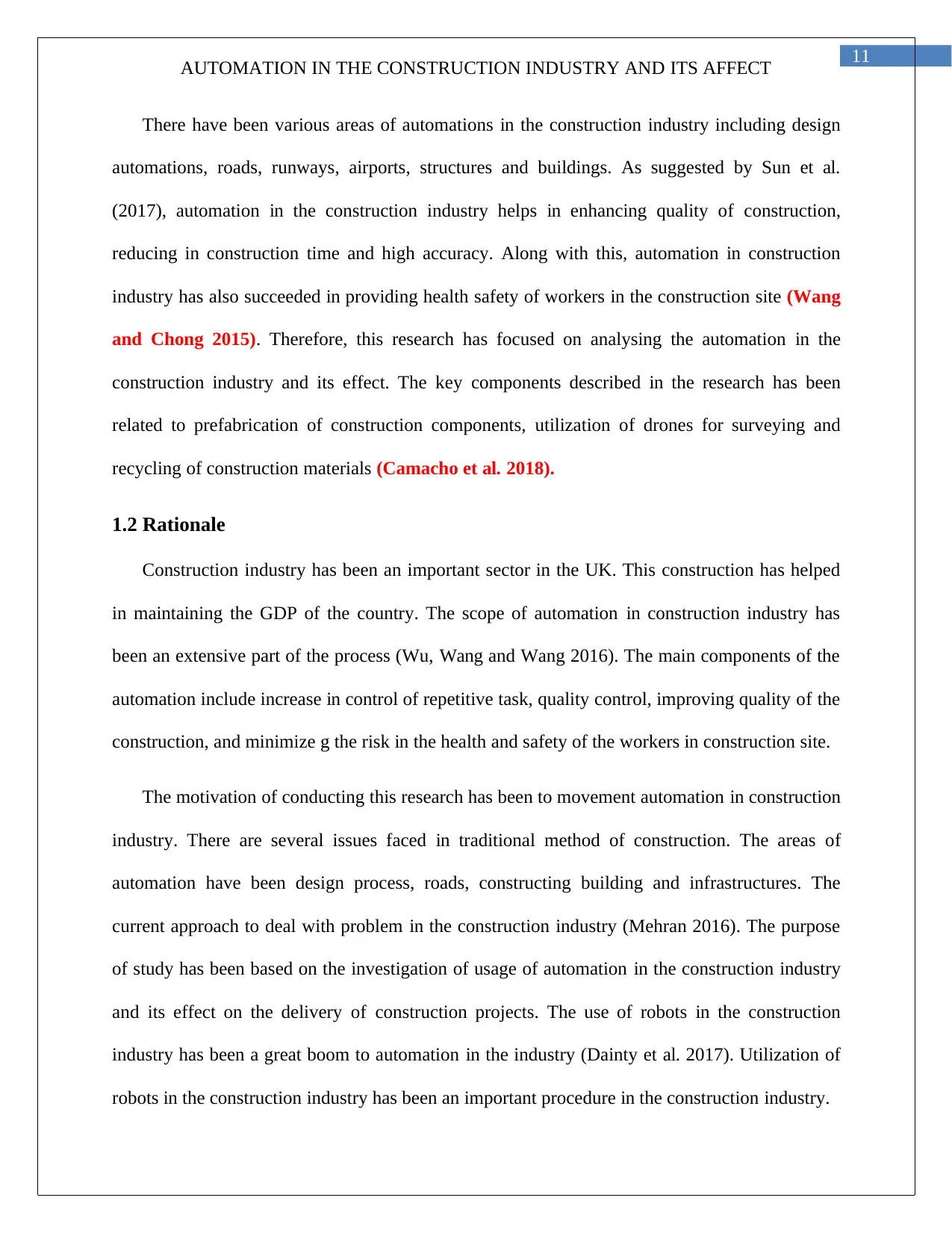
AUTOMATION IN THE CONSTRUCTION INDUSTRY AND ITS AFFECT 11
There have been various areas of automations in the construction industry including design
automations, roads, runways, airports, structures and buildings. As suggested by Sun et al.
(2017), automation in the construction industry helps in enhancing quality of construction,
reducing in construction time and high accuracy. Along with this, automation in construction
industry has also succeeded in providing health safety of workers in the construction site (Wang
and Chong 2015). Therefore, this research has focused on analysing the automation in the
construction industry and its effect. The key components described in the research has been
related to prefabrication of construction components, utilization of drones for surveying and
recycling of construction materials (Camacho et al. 2018).
1.2 Rationale
Construction industry has been an important sector in the UK. This construction has helped
in maintaining the GDP of the country. The scope of automation in construction industry has
been an extensive part of the process (Wu, Wang and Wang 2016). The main components of the
automation include increase in control of repetitive task, quality control, improving quality of the
construction, and minimize g the risk in the health and safety of the workers in construction site.
The motivation of conducting this research has been to movement automation in construction
industry. There are several issues faced in traditional method of construction. The areas of
automation have been design process, roads, constructing building and infrastructures. The
current approach to deal with problem in the construction industry (Mehran 2016). The purpose
of study has been based on the investigation of usage of automation in the construction industry
and its effect on the delivery of construction projects. The use of robots in the construction
industry has been a great boom to automation in the industry (Dainty et al. 2017). Utilization of
robots in the construction industry has been an important procedure in the construction industry.
There have been various areas of automations in the construction industry including design
automations, roads, runways, airports, structures and buildings. As suggested by Sun et al.
(2017), automation in the construction industry helps in enhancing quality of construction,
reducing in construction time and high accuracy. Along with this, automation in construction
industry has also succeeded in providing health safety of workers in the construction site (Wang
and Chong 2015). Therefore, this research has focused on analysing the automation in the
construction industry and its effect. The key components described in the research has been
related to prefabrication of construction components, utilization of drones for surveying and
recycling of construction materials (Camacho et al. 2018).
1.2 Rationale
Construction industry has been an important sector in the UK. This construction has helped
in maintaining the GDP of the country. The scope of automation in construction industry has
been an extensive part of the process (Wu, Wang and Wang 2016). The main components of the
automation include increase in control of repetitive task, quality control, improving quality of the
construction, and minimize g the risk in the health and safety of the workers in construction site.
The motivation of conducting this research has been to movement automation in construction
industry. There are several issues faced in traditional method of construction. The areas of
automation have been design process, roads, constructing building and infrastructures. The
current approach to deal with problem in the construction industry (Mehran 2016). The purpose
of study has been based on the investigation of usage of automation in the construction industry
and its effect on the delivery of construction projects. The use of robots in the construction
industry has been a great boom to automation in the industry (Dainty et al. 2017). Utilization of
robots in the construction industry has been an important procedure in the construction industry.
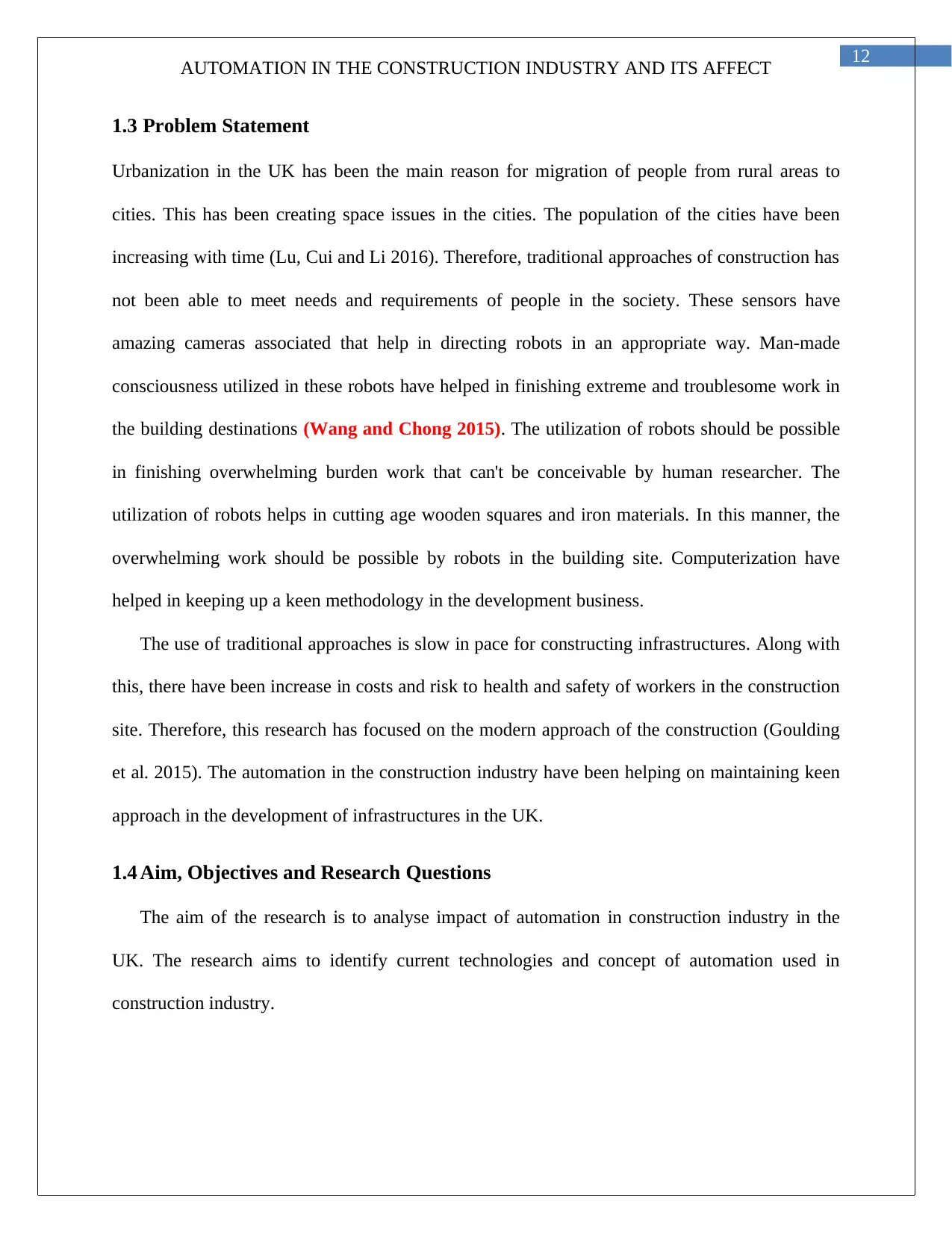
AUTOMATION IN THE CONSTRUCTION INDUSTRY AND ITS AFFECT 12
1.3 Problem Statement
Urbanization in the UK has been the main reason for migration of people from rural areas to
cities. This has been creating space issues in the cities. The population of the cities have been
increasing with time (Lu, Cui and Li 2016). Therefore, traditional approaches of construction has
not been able to meet needs and requirements of people in the society. These sensors have
amazing cameras associated that help in directing robots in an appropriate way. Man-made
consciousness utilized in these robots have helped in finishing extreme and troublesome work in
the building destinations (Wang and Chong 2015). The utilization of robots should be possible
in finishing overwhelming burden work that can't be conceivable by human researcher. The
utilization of robots helps in cutting age wooden squares and iron materials. In this manner, the
overwhelming work should be possible by robots in the building site. Computerization have
helped in keeping up a keen methodology in the development business.
The use of traditional approaches is slow in pace for constructing infrastructures. Along with
this, there have been increase in costs and risk to health and safety of workers in the construction
site. Therefore, this research has focused on the modern approach of the construction (Goulding
et al. 2015). The automation in the construction industry have been helping on maintaining keen
approach in the development of infrastructures in the UK.
1.4 Aim, Objectives and Research Questions
The aim of the research is to analyse impact of automation in construction industry in the
UK. The research aims to identify current technologies and concept of automation used in
construction industry.
1.3 Problem Statement
Urbanization in the UK has been the main reason for migration of people from rural areas to
cities. This has been creating space issues in the cities. The population of the cities have been
increasing with time (Lu, Cui and Li 2016). Therefore, traditional approaches of construction has
not been able to meet needs and requirements of people in the society. These sensors have
amazing cameras associated that help in directing robots in an appropriate way. Man-made
consciousness utilized in these robots have helped in finishing extreme and troublesome work in
the building destinations (Wang and Chong 2015). The utilization of robots should be possible
in finishing overwhelming burden work that can't be conceivable by human researcher. The
utilization of robots helps in cutting age wooden squares and iron materials. In this manner, the
overwhelming work should be possible by robots in the building site. Computerization have
helped in keeping up a keen methodology in the development business.
The use of traditional approaches is slow in pace for constructing infrastructures. Along with
this, there have been increase in costs and risk to health and safety of workers in the construction
site. Therefore, this research has focused on the modern approach of the construction (Goulding
et al. 2015). The automation in the construction industry have been helping on maintaining keen
approach in the development of infrastructures in the UK.
1.4 Aim, Objectives and Research Questions
The aim of the research is to analyse impact of automation in construction industry in the
UK. The research aims to identify current technologies and concept of automation used in
construction industry.
⊘ This is a preview!⊘
Do you want full access?
Subscribe today to unlock all pages.

Trusted by 1+ million students worldwide
1 out of 74
Related Documents
Your All-in-One AI-Powered Toolkit for Academic Success.
+13062052269
info@desklib.com
Available 24*7 on WhatsApp / Email
![[object Object]](/_next/static/media/star-bottom.7253800d.svg)
Unlock your academic potential
Copyright © 2020–2025 A2Z Services. All Rights Reserved. Developed and managed by ZUCOL.





